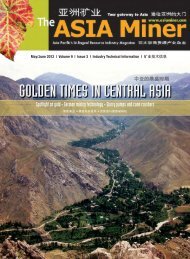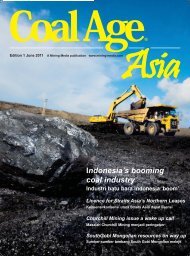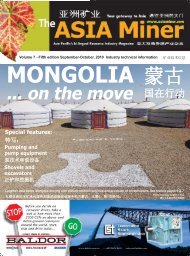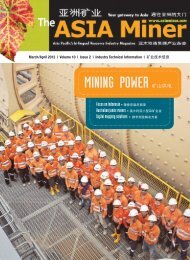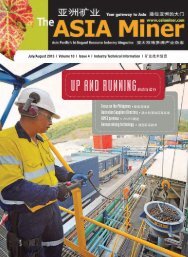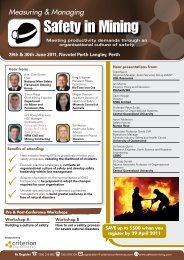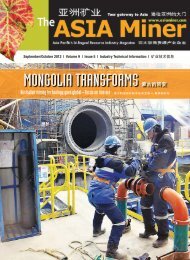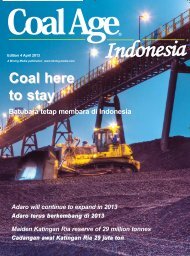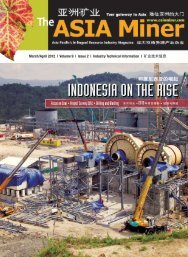May/June 2013 - The ASIA Miner
May/June 2013 - The ASIA Miner
May/June 2013 - The ASIA Miner
You also want an ePaper? Increase the reach of your titles
YUMPU automatically turns print PDFs into web optimized ePapers that Google loves.
Mine Design<br />
CAE Moves Deeper into Mining<br />
A relatively recent entrant into the mine-design<br />
software market, in the past CAE has perhaps<br />
been better known world-wide for its simulator<br />
and training technology. However, the company’s<br />
purchases of Datamine and Century<br />
Systems Technologies has increased its interest<br />
in the mining sector, such that it now has<br />
a dedicated business area, CAE Mining.<br />
CAE Mining supplies software tools for underground<br />
mine planning, including Mine2-4-<br />
D and its successor, CAE Studio 5-D Planner.<br />
<strong>The</strong> company’s Mineable Reserves Optimizer<br />
(MRO) package determines the optimal mining<br />
envelopes within which stopes should be<br />
designed, and can be used for preliminary<br />
underground reserve estimation. <strong>The</strong> Mineable<br />
Shape Optimizer (MSO) automatically<br />
produces optimized stope designs that maximize<br />
the value of recovered ore within the<br />
given geometry and design constraints. It<br />
supports massive, sub-vertical and flat horizontal<br />
deposits and can quickly generate individual<br />
stope designs within a resource<br />
model, CAE Mining says.<br />
In terms of access design, Mine Layout Optimizer<br />
(MLO) produces optimal decline designs<br />
to satisfy access requirements and<br />
design criteria. <strong>The</strong> company suggests that<br />
this can be valuable with rapid engineering<br />
during the analysis stages of a project, as well<br />
later once designs become more detailed.<br />
Hard Dollar says its Project Cost Management (PCM) package enables mining companies to make project decisions<br />
that avoid cost overruns.<br />
evaluate off-shore mineral resources, has<br />
adapted Vulcan 3-D modelling software for its<br />
exploration on 26 mining leases off-shore<br />
Nome, Alaska. Vulcan GeoModeller provides<br />
a complete set of tools for exploration and<br />
mining geologists, and can be used on both<br />
stratigraphic and non-stratigraphic deposits.<br />
<strong>The</strong> Vulcan platform allows users to do resource<br />
modelling, mine planning and reconciliation<br />
in the same environment.<br />
Hard Dollar: Counting Cash Where it Counts<br />
As noted earlier, plenty of mining companies are<br />
feeling the combined effects of soaring capex<br />
costs, upward pressures on operating costs<br />
and uncertainties over commodity markets. In a<br />
presentation given in April last year, Scottsdale,<br />
Arizona-based Hard Dollar commented that<br />
“mining companies must take measures to<br />
manage cash flow and conserve spending,<br />
while ensuring that projects stay on schedule.”<br />
<strong>The</strong> company went on to point out that controlling<br />
costs and managing mining resources<br />
requires a robust tool, suggesting that its Project<br />
Cost Management (PCM) package removes<br />
common hurdles from cost controls,<br />
allowing mining companies to make project<br />
decisions that easily avoid cost overruns.<br />
While not specifically a mine design package,<br />
PCM provides a way of producing detailed,<br />
timely project status data, the company states.<br />
<strong>The</strong>se data immediately show what was estimated<br />
and budgeted, versus actual project performance.<br />
Through customizable daily reports,<br />
an entire project overview is displayed, clearly<br />
showing variances and forecasts at completion.<br />
In July 2012, Hard Dollar teamed up with<br />
Canadian company CAE to include its PCM<br />
in CAE Mining’s mine design, planning and<br />
scheduling software suite. “Hard Dollar’s integration<br />
with the new CAE Studio 5-D Planner<br />
provides customers transparent delivery<br />
of cost and productivity throughout the entire<br />
project lifecycle,” the companies said at the<br />
time, while pointing out that by integrating the<br />
two products in an industry first, they had<br />
provided users with the opportunity to merge<br />
mine design, scheduling, financial and productivity<br />
modelling for both study and operational<br />
environments. According to Hard<br />
Dollar, PCM can reduce the time it takes to<br />
build, plan, deliver and forecast cost and productivity<br />
by more than 300%, while increasing<br />
profits by 15% or more<br />
Good Designs Save Time and Money<br />
With so much pressure on exploration and<br />
mining companies to bring projects on<br />
stream in a cost-effective, timely manner,<br />
while working in increasingly remote and<br />
often logistically challenging environments, it<br />
is hardly surprising that there is a strong market<br />
for comprehensive software tools that can<br />
take some of the risk out of the design<br />
process. Each of the major suppliers has its<br />
own list of ‘satisfied customers’, working in<br />
locations from Nevada to Papua New<br />
Guinea, and from Australia to Appalachia.<br />
It is, of course, sensible to remember that<br />
all of these software packages rely on having<br />
accurate data to work with, so it is essential<br />
that users ensure that their input<br />
information is not only clean, but is as accurate<br />
as can be achieved. After all, the old<br />
maxim ‘garbage-in, garbage-out’ applies to<br />
design software as much as it does to any<br />
other data-reliant process.<br />
In common with other sectors of mining and<br />
exploration technology, there appears to have<br />
been a steady trend toward consolidation within<br />
software suppliers, usually with the aim of amalgamating<br />
complementary products. Most suppliers<br />
claim dominance in one particular aspect<br />
or another, although it is clear that no one company<br />
has an over-riding position in the wider<br />
world market. Software development and computing<br />
power have gone hand-in-hand here as<br />
elsewhere in the industry, with 64-bit technology<br />
becoming mainstream where large<br />
amounts of data have to be handled.<br />
Shareholders should always be able to<br />
see where a project’s design has not met<br />
the mark. Whether they can do anything<br />
about it is, of course, another matter. Perhaps<br />
the best thing about good design is<br />
that it just keeps paying dividends.<br />
64 | <strong>ASIA</strong> <strong>Miner</strong> | <strong>May</strong>/<strong>June</strong> <strong>2013</strong>



